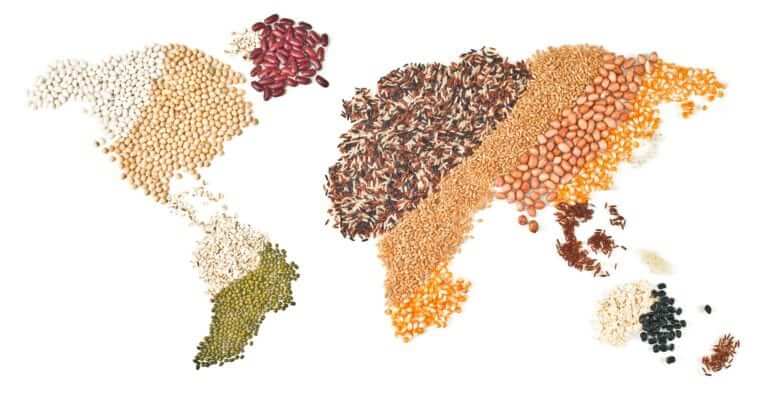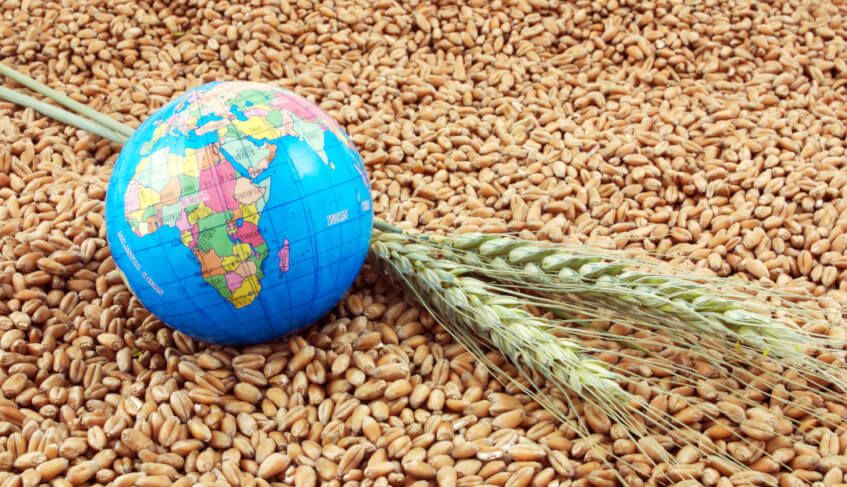Not to be confused with Food safety. Food security is the measure of the availability of food and individuals' ability to access it. According to the United Nations' Committee on World Food Security, food security is defined as meaning that all people, at all times, have physical, social, and economic access to sufficient, safe, and nutritious food that meets their food preferences and dietary needs for an active and healthy life. The availability of food irrespective of class, gender or region is another one. There is evidence of food security being a concern many thousands of years ago, with central authorities in ancient China and ancient Egypt being known to release food from storage in times of famine.
At the 1974 World Food Conference, the term "food security" was defined with an emphasis on supply; food security is defined as the "availability at all times of adequate, nourishing, diverse, balanced and moderate world food supplies of basic foodstuffs to sustain a steady expansion of food consumption and to offset fluctuations in production and prices". Later definitions added demand and access issues to the definition. The first World Food Summit, held in 1996, stated that food security "exists when all people, at all times, have physical and economic access to sufficient, safe and nutritious food to meet their dietary needs and food preferences for an active and healthy life."
Similarly, household food security is considered to exist when all members, at all times, have access to enough food for an active, healthy life. Individuals who are food secure do not live in hunger or fear of starvation. Food insecurity, on the other hand, is defined by the United States Department of Agriculture (USDA) as a situation of "limited or uncertain availability of nutritionally adequate and safe foods or limited or uncertain ability to acquire acceptable foods in socially acceptable ways".
Food security incorporates a measure of resilience to future disruption or unavailability of critical food supply due to various risk factors including droughts, shipping disruptions, fuel shortages, economic instability and wars.
The Food and Agriculture Organization of the United Nations, or FAO, identified the four pillars of food security as availability, access, utilization and stability. The United Nations (UN) recognized the Right to Food in the Declaration of Human Rights in 1948 and has since said that it is vital for the enjoyment of all other rights.
The 1996 World Summit on Food Security declared that "food should not be used as an instrument for political and economic pressure". Multiple different international agreements and mechanisms have been developed to address food security. The main global policy to reduce hunger and poverty is in the Sustainable Development Goals.
In particular Goal 2: Zero Hunger sets globally agreed on targets to end hunger, achieve food security and improved nutrition and promote sustainable agriculture by 2030.

Measurement
Food security can be measured by calories to digest out to intake per person per day, available on a household budget. In general, the objective of food security indicators and measurements is to capture some or all of the main components of food security in terms of food availability, accessibility and utilization / adequacy. While availability (production and supply) and utilization / adequacy (nutritional status / anthropometric measurement) are easier to estimate and therefore, more popular, accessibility (the ability to acquire the sufficient quantity and quality of food) remains largely elusive. The factors influencing household food accessibility are often context-specific.
Several measurements have been developed to capture the access component of food security, with some notable examples developed by the USAID-funded Food and Nutrition Technical Assistance (FANTA) project, collaborating with Cornell and Tufts University and Africare and World Vision.
These include:
- Household Food Insecurity Access Scale: Measures the degree of food insecurity (inaccessibility) in the household in the previous month on a discrete ordinal scale.
- Household Dietary Diversity Scale: Measures the number of different food groups consumed over a specific reference period (24hrs/48hrs/7days).
- Household Hunger Scale: Measures the experience of household food deprivation based on a set of predictable reactions, captured through a survey and summarized in a scale.
- Coping Strategies Index (CSI): Assesses household behaviors and rates them based on a set of varied established behaviors on how households cope with food shortages. The methodology for this research is based on collecting data on a single question; "What do you do when you do not have enough food and do not have enough money to buy food?
Food insecurity is measured in the United States by questions in the Census Bureau's Current Population Survey. The questions asked are about anxiety that the household budget is inadequate to buy enough food, inadequacy in the quantity or quality of food eaten by adults and children in the household and instances of reduced food intake or consequences of reduced food intake for adults and for children.
A National Academy of Sciences study commissioned by the USDA criticized this measurement and the relationship of "food security" to hunger, adding "it is not clear whether hunger is appropriately identified as the extreme and of the food security scale."
Recently, FAO has developed the Food Insecurity Experience Scale (FIES) as a universally applicable experience-based food security measurement scale derived from the scale used in the United States. Thanks to the establishment of a global reference scale and the procedure needed to calibrate measures obtained in different countries, it is possible to use the FIES to produce cross-country comparable estimates of the prevalence of food insecurity in the population.
Since 2015, the FIES has been adopted as the basis to compile one of the indicators included in the Sustainable Development Goals (SDG) monitoring framework.
The Food and Agriculture Organization of the United Nations (FAO), the World Food Programme (WFP), the International Fund for Agricultural Development (IFAD), the World Health Organization (WHO) and the United Nations Children's Fund (UNICEF) collaborate every year to produce The State of Food Security and Nutrition in the World, or SOFI report (known as The State of Food Insecurity in the World until 2015).
The SOFI report measures chronic hunger (or undernourishment) by means of two main indicators, the Number of undernourished (NoU) and the Prevalence of undernourishment (PoU). Beginning in the early 2010s, FAO incorporated more complex metrics into its calculations, including estimates of food losses in retail distribution for each country and the volatility in agri-food systems. Since 2016, it also reports the Prevalence of moderate or severe food insecurity based on the FIES.
Recent editions of the SOFI report present evidence that the decades-long decline in hunger in the world, as measured by the Number of undernourished (NoU), has ended. In the 2020 report, FAO used newly accessible data from China to revise the global NoU downwards to nearly 690 million, or 8.9 percent of the world population – but having recalculated the historic hunger series accordingly, it confirmed that the number of hungry people in the world, albeit lower than previously thought, had been slowly increasing since 2014.
On broader measures, the SOFI report found that far more people suffered some form of food insecurity, with 3 billion or more unable to afford even the cheapest healthy diet. Nearly 2.37 billion people did not have access to adequate food in 2020 – an increase of 320 million people compared to 2019. FAO's 2021 edition of The State of Food and Agriculture (SOFA) further estimates that an additional 1 billion people (mostly on lower- and upper-middle-income countries) are at risk of not affording a healthy diet if a shock were to reduce their income by a third.
Rates
The 2021 edition of the SOFI report estimated the hunger excess linked to the COVID-19 pandemic at 30 million people by the end of the decade – FAO had earlier warned that even without the pandemic, the world was off track to achieve Zero Hunger, or Goal 2 of the Sustainable Development Goals – it further found that already in the first year of the pandemic, the prevalence of undernourishment (PoU) had increased 1.5 percentage points, reaching a level of around 9.9 percent. This is the mid-point of an estimate of 720 to 811 million people facing hunger in 2020 – as many as 161 million more than in 2019. The number had jumped by some 446 million in Africa, 57 million in Asia, and about 14 million in Latin America and the Caribbean.
At the global level, the prevalence of food insecurity at moderate or severe level, and severe level only, is higher among women than men, magnified in rural areas. The gender gap in accessing food increased from 2018 to 2019, particularly at the moderate or severe level. Today, more than one billion women and girls around the world still do not have access to the healthy diets they need to survive and thrive and two-thirds of countries report higher rates of food insecurity for women than men especially in the Near East area.
Examples of food insecurity
Famines have been frequent in world history. Some have killed millions and substantially diminished the population of a large area. The most common causes have been drought and war, but the greatest famines in history were caused by economic policy.
Close to 12 percent of the global population was severely food insecure in 2020, representing 928 million people – 148 million more than in 2019. A variety of reasons lies behind the increase in hunger over the past few years. Slowdowns and downturns since the 2008-9 financial crisis have conspired to degrade social conditions, making undernourishment more prevalent.
Structural imbalances and a lack of inclusive policies have combined with extreme weather events; altered environmental conditions; and the spread of pests and diseases, such as the COVID-19 pandemic, triggering stubborn cycles of poverty and hunger. In 2019, the high cost of healthy diets together with persistent high levels of income inequality put healthy diets out of reach for around 3 billion people, especially the poor, in every region of the world.
Inequality in the distributions of assets, resources and income, compounded by the absence or scarcity of welfare provisions in the poorest countries, are further undermining access to food. Nearly a tenth of the world population still lives on US$1.90 or less a day, with sub-Saharan Africa and southern Asia the regions most affected.
High import and export dependence ratios are meanwhile making many countries more vulnerable to external shocks. In many low-income economies, debt has swollen to levels far exceeding GDP, eroding growth prospects.
Finally, the world is facing ever greater threats to institutional stability, protracted violence and mass displacement due to conflicts. Between 2010 and 2018, the number of displaced people grew by 70 percent to reach 70.8 million, most of whom were being hosted in developing countries.
References: https://en.wikipedia.org/wiki/Food_security









